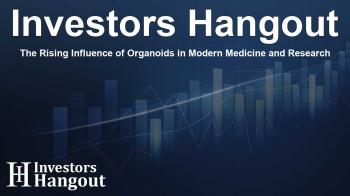The Rising Influence of Organoids in Modern Medicine and Research

The Transformational Role of Organoids in Healthcare
Organoids have emerged as a compelling innovation in the landscape of medicine, offering a new approach to research and therapeutic development. These miniature, three-dimensional structures mimic the function and architecture of human organs, providing unprecedented insights into human biology. As the organoids market expands, with projections expecting significant growth by 2030, understanding their applications becomes increasingly crucial.
What Drives the Demand for Organoids?
The need for organoids is surfacing dramatically from a host of factors. A prominent influence is the shift towards personalized medicine, where treatments are tailored to individual patients based on their unique biological makeup. The limitations of traditional animal testing are also prompting researchers to adopt organoids as more ethical and precise alternatives. As organoid technology advances, it is becoming integral in cancer research, regenerative medicine, and drug discovery.
Key Benefits of Using Organoids
One of the predominant benefits of organoids is their ability to replicate real human tissues more accurately than previous models. This enables researchers to study disease mechanisms and treatment responses effectively. For instance, patient-derived organoids can be utilized to test various therapeutic interventions, allowing healthcare providers to identify the most effective treatments for their patients.
Market Insights and Growth Projections
Market analysis indicates a surge in the organoids sector, estimated to grow at a compound annual growth rate (CAGR) of approximately 14% until 2030. North America currently holds a significant share of the market, attributed to the prevalence of biotechnology and pharmaceutical companies that are heavily investing in organoid research to enhance drug development processes.
Leading Companies and Innovations
Companies such as Thermofisher Scientific, StemCell Technologies, and Organovo Holdings are at the forefront of organoid development. Innovations in this space are manifold; for example, recent partnerships between pharma-tech firms aim to create user-friendly organoid-based kits that improve drug safety testing. These developments underscore the collaborative spirit within the industry, driving advancements that benefit patient health outcomes.
Implications for Future Research
The implications of organoid research are immense, spanning various therapeutic areas. Organoids are proving invaluable in modeling complex diseases, including neurological disorders and cancers. By allowing scientists to examine tumor behavior in a laboratory setting, the hope is to discover new ways to combat resistant forms of cancer. This avenue of research not only enhances our understanding of diseases but also paves the way for the formulation of novel therapies.
Challenges in Organoid Adoption
Despite the potential, several challenges exist regarding the widespread adoption of organoid technologies. Developing and maintaining organoids can be complex and costly, making it challenging for smaller research institutions to harness their benefits fully. Additionally, while organoids can closely mimic human tissues, some limitations remain, such as the absence of vascular structures and immune responses, which may affect their applicability in certain research areas.
Future Directions and Opportunities
Looking ahead, the organoid market is poised for continued growth as technological strides facilitate the enhancement of these models. Collaboration between academic organizations and the biopharma industry is likely to stimulate further innovation, expanding organoid applications across therapeutic domains. As ethical considerations gain importance in research, organoids may play a pivotal role in reducing reliance on animal testing and improving the reliability of drug development processes.
Frequently Asked Questions
What are organoids and why are they important?
Organoids are 3D cellular structures that replicate human organs, offering researchers valuable tools to study diseases and test treatments in a more ethical manner than traditional methods.
What is driving the growth of the organoids market?
The organoids market is seeing growth due to the rising demand for personalized medicine, the need for more reliable preclinical testing, and advancements in biotechnology.
Which regions are leading in organoid market share?
North America currently dominates the organoid market, driven by a robust presence of biotechnology firms and increased investment in research.
What roles do major companies play in the organoid market?
Leading companies are involved in research and development, creating innovative organoid products, and forming partnerships that enhance drug safety testing and therapy personalization.
What is the future outlook for organoid technology?
The future of organoid technology is optimistic, with potential advancements expected to increase its application in various therapeutic areas while addressing current limitations.
About Investors Hangout
Investors Hangout is a leading online stock forum for financial discussion and learning, offering a wide range of free tools and resources. It draws in traders of all levels, who exchange market knowledge, investigate trading tactics, and keep an eye on industry developments in real time. Featuring financial articles, stock message boards, quotes, charts, company profiles, and live news updates. Through cooperative learning and a wealth of informational resources, it helps users from novices creating their first portfolios to experts honing their techniques. Join Investors Hangout today: https://investorshangout.com/
Disclaimer: The content of this article is solely for general informational purposes only; it does not represent legal, financial, or investment advice. Investors Hangout does not offer financial advice; the author is not a licensed financial advisor. Consult a qualified advisor before making any financial or investment decisions based on this article. The author's interpretation of publicly available data shapes the opinions presented here; as a result, they should not be taken as advice to purchase, sell, or hold any securities mentioned or any other investments. The author does not guarantee the accuracy, completeness, or timeliness of any material, providing it "as is." Information and market conditions may change; past performance is not indicative of future outcomes. If any of the material offered here is inaccurate, please contact us for corrections.
